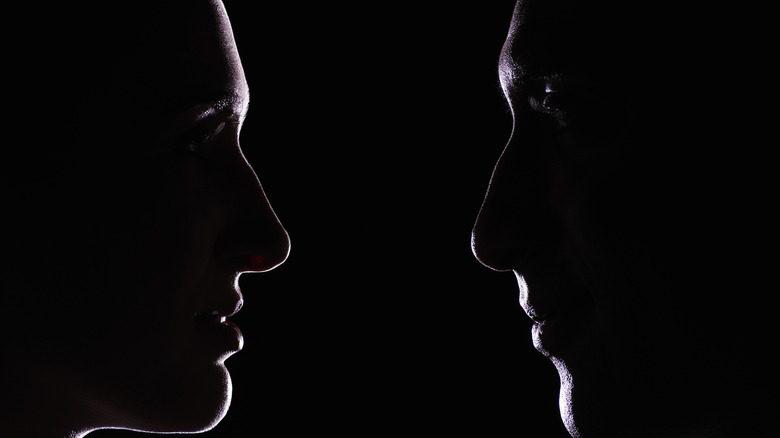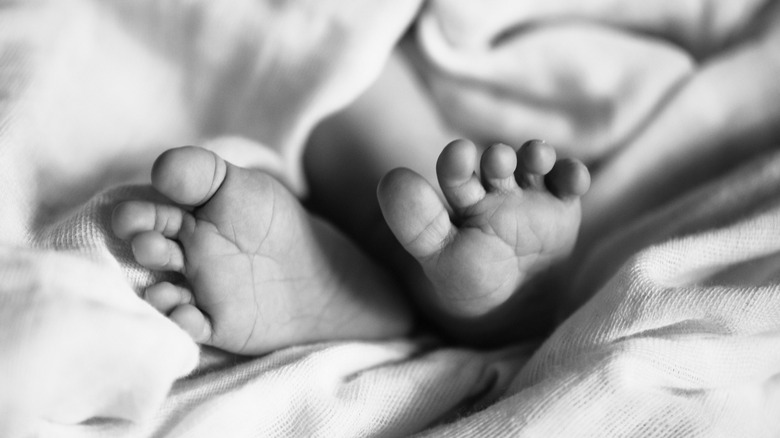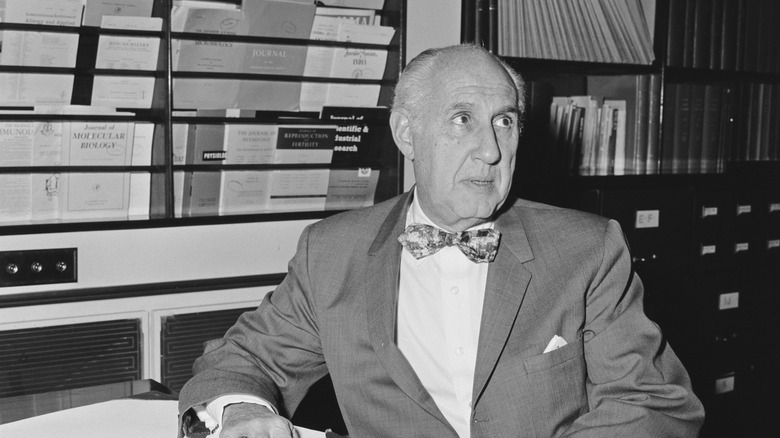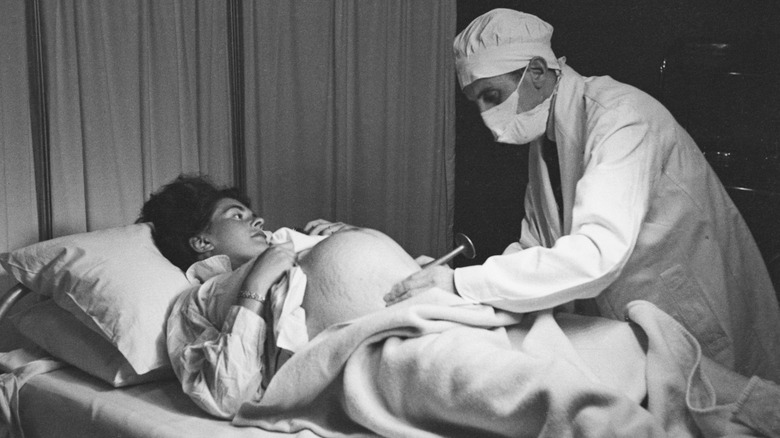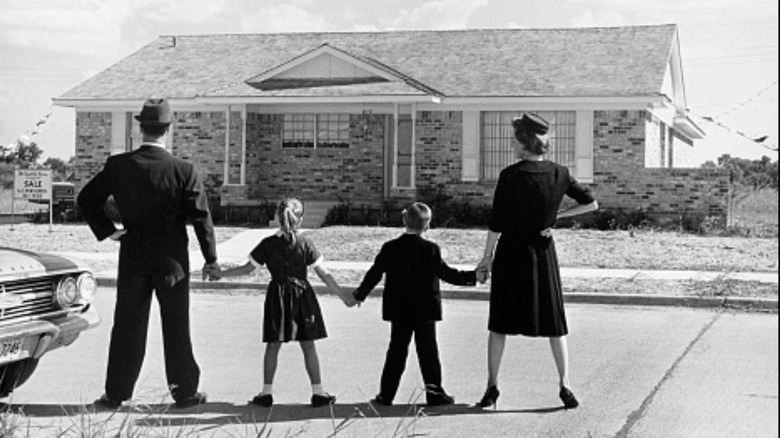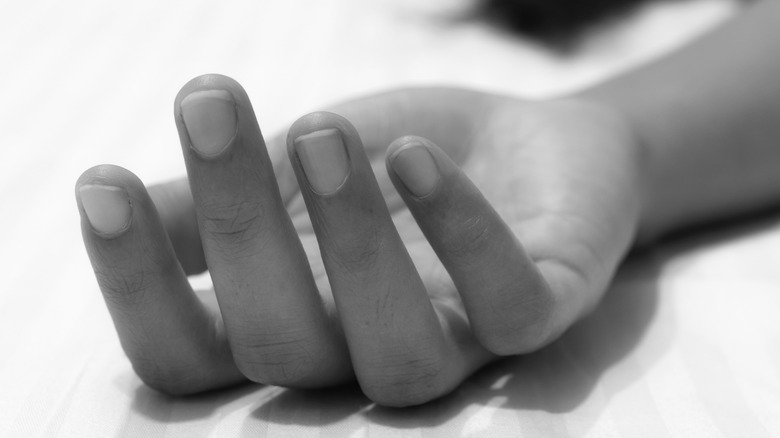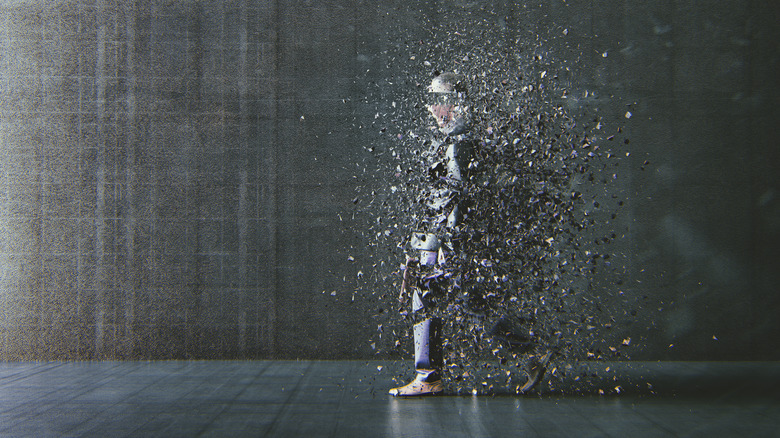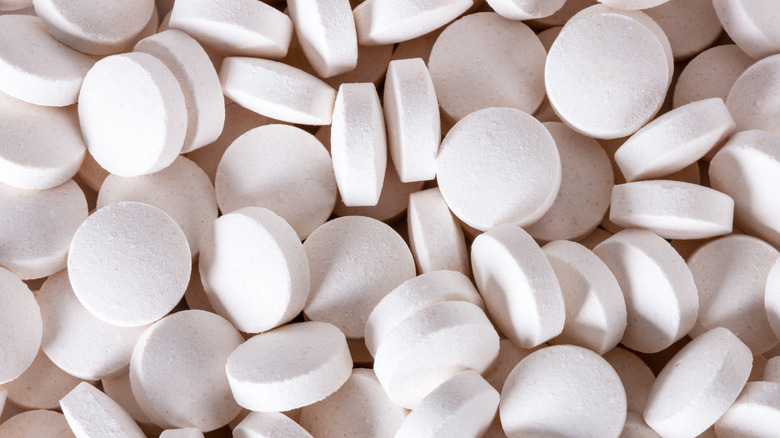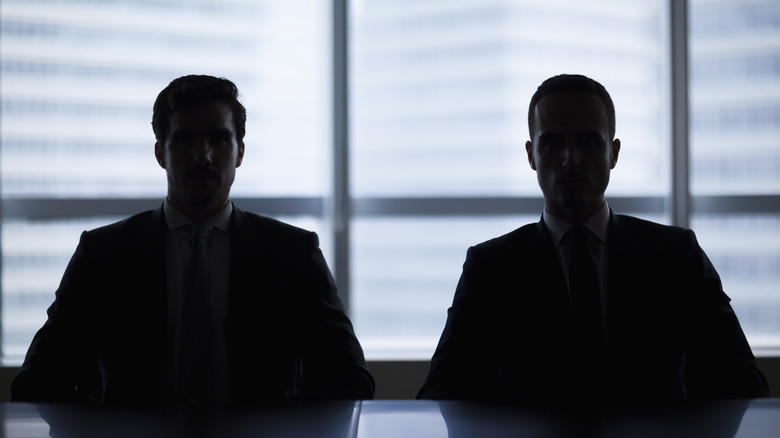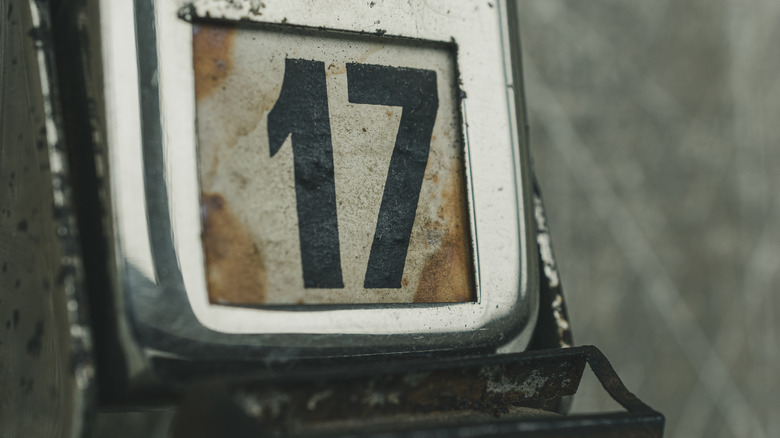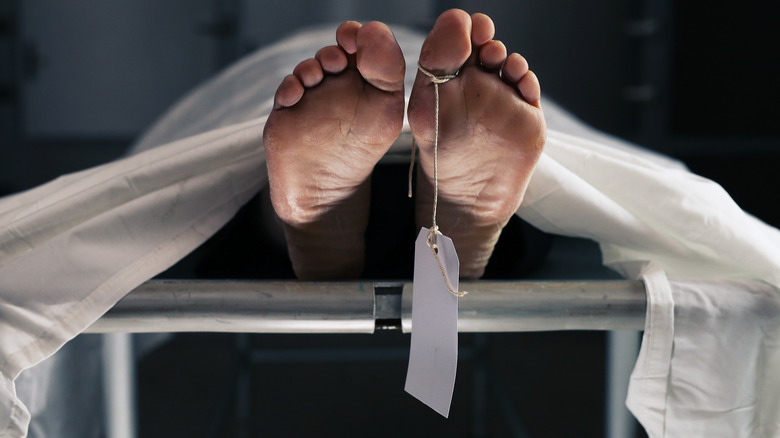The Lives And Bizarre Deaths Of The Real-Life Twin Gynecologists
Many pop culture depictions of twins hinge on their spooky nature. They have an eerie mind meld, some stories say, or are so closely intertwined that it's all but impossible to discern one from the other. For the vast majority of twins, this is all pretty unfair. As anyone who's a twin will surely tell you, they don't share a single mind and rarely, if ever, go around menacing the lead in a horror movie.
However, there are occasionally real sets of twins who start to tip over into something genuinely strange. Sometimes, as in the case of June and Jennifer Gibbons, they experience social and mental health issues from a young age. Others aren't so obvious. In the case of the Marcus brothers, things started great. Both Stewart and Cyril were high achievers who became well-regarded doctors. Sure, they seemed a bit too attached, going to the same schools and even running a shared practice, but they helped many people.
At some point, however, the brothers began to spiral. Their situation, once so impressive, became so dire that they were found dead in July 1975, surrounded by filth. What went so terribly wrong? And what killed these high-flying doctor brothers? The truth may be far more complicated than you think.
Stewart and Cyril Marcus were found in a shocking state
The first indicator that something had gone well and truly wrong was the smell. Sure, the two men had been acting strange for a while and weren't known to be friendly to anyone in the apartment building. But they were doctors who probably had things together. This was New York City, too, and perhaps other tenants wanted to mind their own business and get on with their lives. Moreover, it was July 17, 1975, the height of summer, and city smells could get eye-watering.
But Bill Terrell, the apartment's repairman, couldn't ignore the stench. A veteran, he claimed to be familiar with the smell of human decomposition, which he said was leaking out of apartment 10H. When a small group finally breached the unit's door, they found that Terrell was all too right. As they made their way past piles of debris, which reportedly included half-eaten meals and human waste deposited in an armchair, they found the twins. Stewart and Cyril Marcus, both once well-regarded doctors who could have been pioneers in their field, lay dead in the bedroom surrounded by pills.
After some initial confusion, authorities were able to identify the brothers. Stewart had died days earlier, wearing just a single sock and shorts, and had begun to decompose on the bed. Cyril, more recently deceased, was on the floor and wore a pair of socks and some paper draped over his body.
The twins were born in 1930
Of the two brothers, Stewart was believed to have been born first, on June 2, 1930. Reportedly, this was a pattern of dominance that would characterize the rest of their lives, with Cyril always seeming to fall just within his slightly older brother's shadow. Both were high achievers, yet it was Stewart who ended up class valedictorian, while Cyril earned second place as salutatorian. He also seemed to get more attention and eventually took on the more interesting work in their shared medical practice, doing engaging lab experiments and making connections for grants. Meanwhile, Cyril seems to have resigned himself to the steady drudgery of keeping their medical careers going with the day-to-day work of managing patients.
Yet, for all the quasi-mystical talk of spooky twins with a deep emotional and mental connection, there was one issue: they weren't identical. A reporter from Esquire found an issue of the Marcuses' high school newspaper that referred to them as fraternal twins, albeit ones who bore a close resemblance. Though Stewart and Cyril would later allow acquaintances, patients, and investigators to think that they were identical, the truth may have been at least slightly different.
The brothers may have been forcibly separated in medical school
When the twins decided on a medical career, they remained paired throughout most of it, attending both college and medical school at Syracuse University. But when they embarked on their residency program at Mt. Sinai Hospital in New York City (after completing an internship there — together, of course), the two encountered a serious roadblock: Dr. Alan Guttmacher.
As the head of gynecology at the hospital, Guttmacher was certainly a formidable figure. He only becomes more so when you consider the rest of his legacy. Guttmacher, who died in 1974, was a prominent advocate for birth control and abortion access. He not only became the first Director of Obstetrics and Gynecology at Mt. Sinai in 1952, but he also became the president of Planned Parenthood a decade later.
Guttmacher was also a twin. Between advocating for better reproductive health and running a medical department, he also occasionally wrote about the psychology of twins. It wasn't flattering. Per Esquire, he went so far as to call improperly individualized twins monsters. When he looked at the Marcuses, it seemed that he saw a dangerous level of enmeshment. Guttmacher's solution was to force them thousands of miles apart, landing Cyril a position at another New York City hospital while Stewart was sent to Stanford University Hospital in California. They spent more than three years apart, until both gained positions at the Guttmacher-free New York Hospital.
The twins had a promising career in women's health
Though some practitioners may have balked at the enmeshed nature of the twins' lives and careers, no one could deny their achievements. Even in high school, Esquire reports, both Stewart and Cyril were members of the National Honor Society and scored top marks at Bayonne High School in New Jersey. In their professional lives, they kept busy publishing in medical and academic journals. They gained special acclaim for their work compiling a textbook, "Advances in Obstetrics and Gynecology," which was published in 1967 and became a highlight of their shared career. After that, New York Hospital tasked them with leading its infertility clinic.
Further into their medical careers, with a shared OB/GYN practice at New York Hospital, they gained a reputation as nothing less than fertility miracle workers. They were so popular that their clientele eventually included some of the city's elite (the brothers reportedly told their class-conscious patients that the pair was from New York, not New Jersey).
Cyril attempted to be a family man
During their years-long separation, with Cyril in California and Stewart remaining in New York, younger twin Cyril got married. However, after Cyril rejoined Stewart in New York, his family life began to crumble. He now had two children, but was so wrapped up in the work of the infertility clinic that he had little time for his family. As one nurse told Esquire, she believed that this was the time that Cyril began taking amphetamines in an attempt to keep up. But it wouldn't work, at least as far as his neglected family was concerned. His wife asked for a divorce in 1969, and by spring 1970, he had moved into the apartment building where he and Stewart would be found dead five years later.
Still, as Linda Wolfe wrote for New York (via Vulture), Cyril's wife may have retained some feeling for him, though it could well have been tinged by respect, pity, or some other emotion she didn't care to explain to reporters who interviewed her in the wake of her ex-husband's death.
Stewart, meanwhile, never seemed interested in matrimony. He certainly never bothered to marry anyone and blithely dismissed the notion of settling down. Why would he? While Cyril was stuck seeing patients, Stewart was off to conferences or writing interesting papers. Stewart even accepted a teaching position at New York Hospital-Cornell Medical Center, putting all the work of the practice on his brother's shoulders.
Cyril suffered a mysterious episode in 1972
In 1972, repairman Bill Terrell noticed an odd buzzing coming from 10H, Cyril's apartment. After it went on for hours, he knocked on the door, to no avail. Terrell found Stewart's phone number and called him. According to New York magazine, Terrell said, "There's something not quite kosher at your brother's place. I think your brother needs help" (via Vulture).
But Stewart was oddly lackadaisical about coming to his brother's aid. Terrell's phone conversation with him was punctuated by long pauses. When Stewart finally showed up at the apartment, opened the door, and found his brother lying on the floor and unresponsive, he also proved reluctant. Despite his medical training, Stewart would not perform CPR on Cyril, first asking Terrell to do it and then allowing doctors to step in for him. Cyril was eventually revived, though the cause of his collapse — stress? Drugs? Lack of food? Some other condition? — wasn't quite clear.
Writing for Esquire, Ron Rosenbaum and Susan Edmiston speculate that Cyril's attack was a stroke. As he lay there, his brain may have become starved of oxygen, going so long without that he suffered brain damage. Whatever caused the incident, it had lasting repercussions for both brothers. Already on a downward spiral, Cyril seemed to grow even more unpredictable and aggressive. He confided in patients and targeted others. Stewart, meanwhile, seems to have felt obliged to cover for his twin, perhaps even feeling guilt for standing by while Cyril lay unconscious.
Their career crumbled even further
Stewart's career began to crumble not long after Cyril's episode. He gave up his prestigious post at New York Hospital-Cornell Medical Center. Then, a second volume of their book, which had once brought them great acclaim, was canceled. Towards the end, the two even left running the fertility clinic and began providing abortions — necessary work, to be sure, but it just didn't carry the same prestige as helming a medical practice catering to the city's elite. Soon, just about everyone around them saw that the brothers were spiraling. But no one knew exactly what was going on, or how to help them. Reporter Linda Wolfe pointed to the sometimes secretive world of doctors, whom she argued closed ranks around the increasingly embarrassing twin physicians (via Vulture).
It didn't help that both brothers were notoriously private. Multiple patients and colleagues told New York magazine reporter Linda Wolfe that the twins did little to socialize and often presented as downright unfriendly. Even doctors who worked alongside them for years remained in the dark. Moreover, they were sensitive to criticism and even gentle questioning from both patients and other doctors. One physician, who was the chief resident in gynecology at Mt. Sinai Hospital during the twins' residency, told Esquire that both Cyril and Stewart were something of a workplace nightmare. They were obstinate and even hostile.
Drug dependency was a likely factor in their downfall
As the months wore on, it was clear that both twins, but Cyril most obviously, were in trouble. While at the hospital, the increasingly frail and unsteady Cyril suffered a fall in April 1974 and had to be assisted by other doctors. He was also reported to take phone calls with slurred speech (some claimed they could hear Stewart in the background coaching his impaired brother). A nurse at New York Hospital told Esquire that both twins had begun taking amphetamines to keep up.
About a month before their deaths, according to medical staff at New York Hospital who spoke to The New York Times, both Marcus brothers were so impaired that they couldn't perform medical procedures and caused other doctors to give them emergency care. In 1974, one brother even reportedly took a whiff of a patient's anesthesia during an operation. Finally, both brothers were found in Cyril's apartment surrounded by numerous containers of barbiturates, so many that most initially assumed that the two had overdosed.
However, after speaking with their patients, colleagues, and others who knew them, reporter Linda Wolfe argued that drugs couldn't have been the only thing that brought the Marcus brothers down. Mental illness may also have been a factor and, given their shared genetic profile, it's possible that whatever was plaguing Cyril was also working its way through Stewart, albeit in a less obvious manner (via Vulture).
Their behavior grew increasingly strange
In October 1974, when Cyril Marcus was set to meet with an investigator from the state's Department of Professional Conduct, he appeared as scheduled. Maybe. The investigator told Esquire that there was no way he had met the notoriously drugged-out Cyril — the cogent person he spoke with had to have been Stewart. When the investigator asked both Stewart and Cyril to show up at the same time, they skipped the appointment, then asked for a series of extensions.
Stewart very likely felt that he needed to cover for Cyril, who was acting increasingly erratic and had grown frail. In the aftermath of their deaths, Dr. Donald Jason of the Medical Examiner's office informed The New York Times that Cyril, despite being 5'11", weighed only 100 pounds.
Though Cyril was reportedly subject to frightening bursts of rage, both brothers were seriously lacking when it came to connecting with their patients. Writing for New York magazine, Linda Wolfe was told that the twins were especially cruel when questioned or if they believed their patients had gained too much weight over their pregnancies. Another patient said they both insisted on making her go through an uncomfortable procedure twice. Still more noted their coldness. A few even speculated that the twins switched places in the middle of exams without notifying patients. Wolfe, herself once a patient of the brothers, wrote that she stopped seeing them after growing frustrated with their poor bedside manner and lack of communication (via Vulture).
Things unraveled further because of insurance forms
For unknown reasons, the twins dragged their heels on the simple if boring task of signing insurance forms for their patients. Some reported that they had to repeatedly call their practice for weeks or even months, sometimes going to the office in person to get the forms completed. Yet the twins consistently made up excuses to delay the process even further. Eventually, they stopped billing patients, which created even more trouble in the already byzantine world of medical insurance, where those bills were often needed to complete the process. In short, many of the Marcuses' patients were caught in a hellish, bureaucratic limbo because their doctors simply refused to sign a form. Yet, as The New York Times reported, despite the ongoing and very real problems with paperwork, no one made an official complaint about the Marcuses as doctors.
Then, Evelyn Chait came along. For four years, Esquire reported, she and her husband doggedly tried to get the practice to just complete her insurance forms. It got so bad that she approached the New York State Department of Professional Conduct, which finally turned its eye to the increasingly unprofessional practices of the Marcus brothers. Under increased scrutiny, it appears that their behavior deteriorated even further. As the complaints piled up, the department charged the Marcuses and set a trial. Then, by May 1975, their department head effectively forced them to take leave — or else be terminated.
The timeline of their deaths deepens the mystery
By June 12, 1975, the twins were expected to give their department head a decision — would they voluntarily take leave or see themselves forced out? When they were finally reached, Stewart asked for a five-day extension. June 16 came around, and they still hadn't made up their minds. The matter then went to the hospital's board, which could have meant the Marcus brothers would be ignominiously kicked out, assuming they didn't attempt to defend themselves.
After that, the path of the brothers is hard to follow. At this point, Stewart appears to have moved in with Cyril, perhaps to take care of his ailing brother (and maybe also to keep him from completely tanking their shared career). Neither was especially friendly. Still, despite the distance, one doorman, George Sich, did notice Cyril leaving the apartment on July 15. Thinking Cyril was about to faint, Sich moved to help but was rebuffed.
Cyril was also seen leaving the apartment building that day. When he returned, the man seemed so unsteady that another doorman went with him to apartment 10H, though Cyril entered alone. Stewart was already dead at this point, given that there were already reports of a smell emanating from the apartment and his remains were more decomposed than his brother's. Given that newspapers were already reporting on the discovery of their bodies on July 17, Cyril must have died on July 15 or the day after.
No one is sure how they died
At first, the cause of death for Cyril and Stewart Marcus seemed painfully obvious. Given that there was no sign of forced entry and no obvious trauma on the remains, murder was unlikely. The remnants of many barbiturates were found in the apartment, from pills scattered around the twins themselves to empty vials and bottles left around the apartment. Eventually, those who worked with the brothers would tell investigators that their drug addiction was an open secret. They must have succumbed to their addiction, perhaps suffering accidental or intentional overdoses.
Yet, when it may have begun to look like this was a simple case, the toxicology report upended that pat notion. There were no barbiturates at all in either brother's body. Further testing didn't reveal any other deadly drugs in their system. Neither was it obvious that they had died from withdrawal symptoms like seizures. And, no, besides their weight loss (Stewart had begun to drop pounds as well, though not at Cyril's frightening rate), there were no obvious medical conditions that could have caused their deaths. The Marcuses may have used their medical knowledge to conceal the true nature of their deaths. It's possible it was an accident, but the only truth anyone can rightfully claim, even today, is that we still don't know how the Marcus brothers died in the summer of 1975.
If you or anyone you know needs help with addiction issues, help is available. Visit the Substance Abuse and Mental Health Services Administration website or contact SAMHSA's National Helpline at 1-800-662-HELP (4357).
